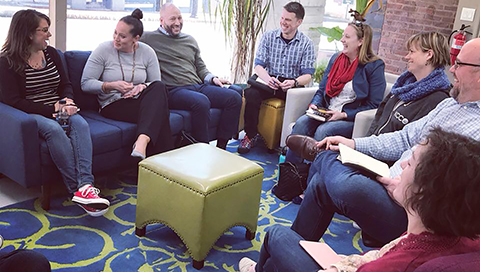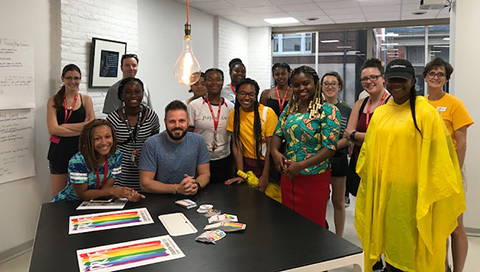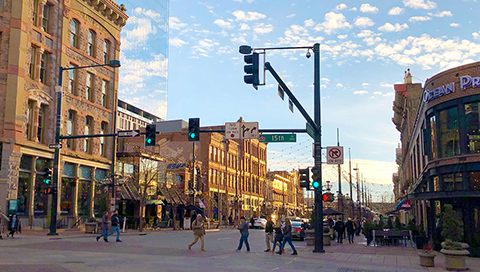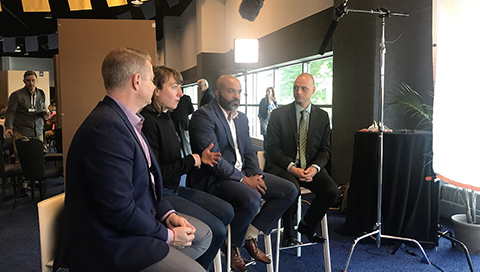Creating spaces of intention
In rural Virginia, and in cities across the country, creating open, inclusive environments that benefit the LGBTQ community benefit the larger entrepreneurial community, as well.
Chris Wood knew something was missing in Staunton, Virginia.
100 miles west of Richmond and surrounded by national parks, the closest LGBTQ resource center was “over a couple of mountains” to Charlottesville, or to Winchester, an hour and a half north, or to Roanoke, an hour and a half south.
Wood co-founded LGBTech, which helps get technology in the hands of homeless LGBTQ youth, but despite its presence in Staunton, he felt its national scope couldn’t meet the needs of Staunton’s LGBTQ community properly.
According to Wood, there’s a long-standing LGBTQ community in Staunton. His vision was to create a resource center to serve it, but his idea was just the first step – figuring out what the community needed, from their own voices, had to come first.
“I recognized that every city, area, community, rural community – they all are different, and they have different needs depending on various inputs,” Wood said. “It could be geography, it could be the specific needs of the individuals in the area, it could be the culture, depending on what part of the United States you’re talking about. With the Shenandoah Valley, it’s no different.”

With the help of Chris Cain, who he’d worked with when Cain was director of the Staunton Innovation Hub, Wood started doing outreach. They did their first big in-person listening session in the Hub space, in a way he felt allowed everyone to feel heard, bringing in around 60 people, both allies and individuals who identify as LGBTQ, from as far as 75 miles away.
Through that first conversation, five main themes the LGBTQ community needed to be addressed became clear: legal and community resources, social opportunities, health and wellness, housing, and education. From there, Wood created the Shenandoah LGBTQ Center to create a “supportive network where LGBTQ people of all ages in the Shenandoah Valley and Greater Appalachia can thrive as equal, healthy, supported members of our society.”
Safe space to reduce barriers
Wood attributes the culture of the Staunton Innovation Hub to the openness of those first conversations. It created a safe space for people to be who they are, to start discussions around gender expressions and gender identity, and for other people to understand or ask questions.
It’s pretty amazing what power safe spaces have.
Andres WydlerExecutive director, StartOut
“It’s important to know and create that safe space because for so long it hasn’t been a safe space,” Wood said.
More specifically, Wood knew as an entrepreneur himself – co-founding LGBTech, founding the Shenandoah LGBTQ Center, as well as co-owning a business with his husband – it was important to create this open environment so that it could serve not just the LGBTQ community, but the larger entrepreneurial community as well.
According to the report, “The State of LGBT Entrepreneurship in the U.S.” from 2016, LGBT people choose to start and run their businesses in places that are more open, tolerant and friendly to the LGBT population. Breaking down barriers to entrepreneurship – especially for those who are underserved and underestimated – is a priority for many cities and regions hoping to improve their local economies with the benefits of new business growth.
Andres Wydler, executive director of StartOut, which connects and educates LGBTQ entrepreneurs to empower great leaders and businesses in cities across the country, said the biggest barriers that LGBTQ entrepreneurs face is self-confidence and access to resources.
Fear creates a lack of self-confidence, Wydler said. Among LGBTQ entrepreneurs, as well as any kind of underrepresented entrepreneur, he said there’s a fear that they have to perform better than entrepreneurship’s straight, white male archetype, which can prevent them from seizing opportunities when they’re presented with them. Related, this fear makes it difficult to break into what Wydler calls the “old boys network” of funding or business development, when not being a part of these networks reduces the quality and quantity of access to resources.
“It’s pretty amazing what power safe spaces have,” Wydler said. “It goes directly back to those barriers. The number one value the StartOut growth lab brings to [the entrepreneurs] is the interaction. Seeing other entrepreneurs in their same position, hearing their stories, hearing how they got around some of these barriers – just having that motivational environment is an enormous value.”
Having an environment where self-confidence can grow helps reduce the other major barrier LGBTQ entrepreneurs face – access to resources. Wydler said a solid network of resource providers that any underrepresented entrepreneur can trust is a critical piece of success.
Wood sees the same environment growing at the Staunton Innovation Hub.
“When you have a space like the Hub that’s operating with an entrepreneurial spirit bringing people together, not only are you ensuring that people are connected, but you’re allowing ideas to be shared between businesses, nonprofits, and individuals who come from different backgrounds,” Wood said. “It allows for opportunities of partnership and collaboration in ways that I think are not possible if you’re siloed.”
At the Hub, Cain said they work hard to make sure everybody feels part of an inclusive community.

“We are making sure that everybody who walks through the doors understands that we don’t tolerate anything other than an inclusive and loving environment,” Cain said.
Almost everyone who works out of the coworking space has a Staunton Pride shirt, Cain said. The Hub has sticker on the front door that reads, “All people are welcome.”
Being intentional about having diverse and inclusive spaces requires endurance, Wydler said. Being an entrepreneur is hard, and the more intersectionality you add, Wydler said, the job becomes exponentially harder – even the best intentions won’t solve all the issues.
“It takes time,” he said. “It takes trust, but then also it takes time for those relationships amongst the entrepreneurs to flourish and to provide that powerful network to support each other. I see success where it is a truly prolonged, solid, and thorough support.”
Sometimes, it takes just one conversation to create a ripple effect.
“Maybe it starts with a small group of people,” Wood said. “But then maybe it expands from there. It just takes someone’s initiative to go out and do it.”


